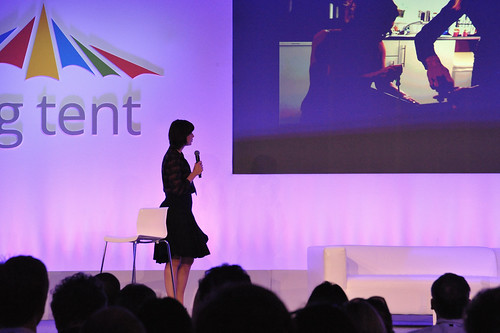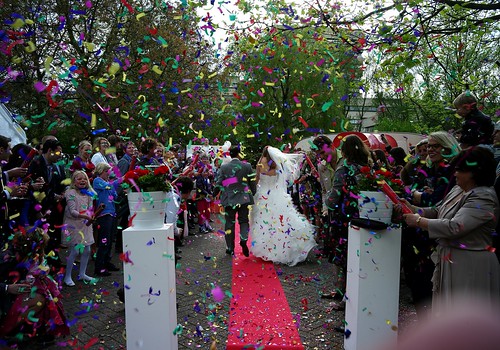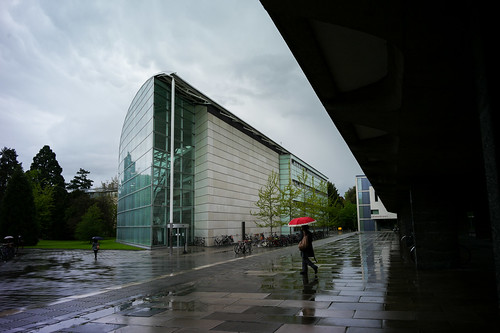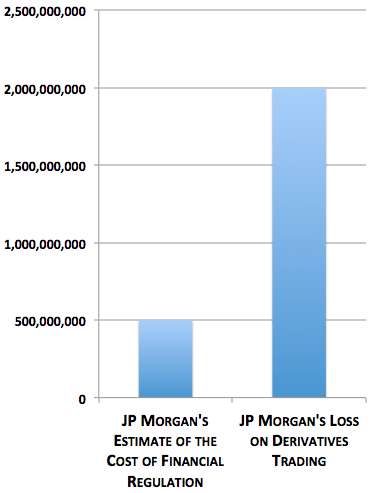Aleks Krotoski, by far the most elegant presenter at the Google Big Tent event yesterday.
The hype marketers
Insightful Guardian column by Dean Baker.
Of course, Facebook is unlikely to go out of business, but it is certainly possible that its business model is not sufficiently robust to justify a position among corporate America’s elite in market capitalization. A year or two down the road, it may well turn out that its share price ends up at half or less of its IPO price (at time of writing, it is already off 13%).
In this case, there will have been an enormous transfer of wealth from the purchasers of Facebook stock to those able to cash out following the IPO. This will make many of those on the inside of the company fantastically wealthy. However, much of their wealth would not result from making a good product that society valued; rather, it came from being part of a successfully hyped company.
These insiders benefited from the ability of Mark Zuckerberg and his colleagues to convince investors that Facebook had much more profit potential than, in fact, was true. This ability to hype a product (in this case, company stock) can be an incredibly valuable skill, but it provides nothing of value to society. In that way, it is similar to the skills of Fabrice Tourre (aka “Fabulous Fab”), who was apparently very skilled in putting together complex mortgage derivatives for Goldman Sachs that were designed to fail.
ALSO: Interesting WSJ video conversation about Facebook’s feeble showing on smartphones.
And now this story:
Financial regulators are to investigate whether the banks in charge of Facebook’s initial stock offering broke the rules by selectively releasing negative news about the company before shares went on sale.
The financial industry regulatory authority (Finra) is looking into allegations that Morgan Stanley and other banks released reduced revenue forecasts for Facebook to big investors – but not the general public – before Friday’s IPO. Such activity could constitute a violation of securities law.
The gatekeepers’ demise
We went to a lovely lunch yesterday given by a friend who is a very successful writer. Inevitably, the conversation turned to the kind of topics that preoccupy professional writers — the changes that are happening to the book-publishing business; how reviews in big newspapers matter so much less nowadays than they once did; the way agents and some publishers (with some notable exceptions) seem to be in that same dreamlike state of denial one once observed in record executives and newspaper editors; and so on. The one thing my friend seemed entirely unaware of was what Amazon is doing to the self-publishing business. He was shocked by my explanation of the simple process by which one can transform a book draft in Microsoft Word into a Kindle eBook (as Jeff Jarvis did recently, for example). So it was interesting to turn to the New York Times this morning and find this quote from Jeff Bezos in a column by Tom Friedman:
“I see the elimination of gatekeepers everywhere,” said Bezos. Thanks to cloud computing for the masses, anyone anywhere can for a tiny hourly fee now rent the most powerful computing and storage facilities on Amazon’s “cloud” to test any algorithm or start any company or publish any book. Start-ups can even send all their inventory to Amazon, and it will do all the fulfillment and delivery — and even gift wrap your invention before shipping it to your customers.This is leading to an explosion of new firms and voices. “Sixteen of the top 100 best sellers on Kindle today were self-published,” said Bezos. That means no agent, no publisher, no paper — just an author, who gets most of the royalties, and Amazon and the reader.
The truth about Facebook
My take on the Facebook IPO. From this morning’s Observer
There are two classes of share – A and B. Each class B share carries 10 times the voting rights of its class A counterpart. Zuck owns 27.1% of the class B shares outright and the company’s pre-IPO filings to the Securities and Exchange Commission revealed agreements with other owners of class B shares to assign their voting rights to him. The net result is that he has voting control over at least 57.1% of the class B shares. In other words, he’s omnipotent.
This would be a problem even if Zuck had the brains of Einstein and the wisdom of Solomon. But, alas, he doesn’t. He is undoubtedly a smart and talented guy, but he also happens to have a megalomaniacal obsession – that everything has to be social, ie public. And if you’re a Facebook user and don’t like that – well, tough.
So we now have another powerful media company with a shareholding structure that renders its charismatic, single-minded founder immune from shareholder pressure. Remind you of anyone? Hint: it begins with “News”.
Taming the email monster
This morning’s Observer column.
Email has become the central communications channel of all modern organisations, to the point where none of them could now function without it. But there’s increasing evidence – both anecdotal and empirical – that it has become dysfunctional. It eats into people’s working and thinking time, for example, distracts them from doing “real” work and generates guilt feelings that ratchet up stress levels to unsustainable levels.
In the old world of desktop PCs, you could at least leave it behind when you left the office. But the advent of the smartphone changed all that. Email has now infiltrated leisure time, family time – even sleep time. It’s become a monster that’s destroying our lives.
Deep down, most of us know this. But we daren’t talk about it out loud, for fear of seeming inadequate…
The wedding blizzard
We went to a lovely wedding of a friend’s daughter in Holland just over a week ago. It was a large and lavish affair, and there were two very good professional photographers in attendance. But I got the “money shot” (he said, modestly)!
Larger version here.
Quote of the day: Cogito Interruptus
“Cogito interruptus is typical of those who see the world inhabited by symbols or symptoms. Like someone who, for example, points to the little box of matches, stares hard into your eyes, and says, ‘You see, there are seven…,’ then gives you a meaningful look, waiting for you to perceive the meaning concealed in that unmistakable sign.”
Umberto Eco, quoted here.
Any port in a storm
The Law Faculty library, in the rain, after a hailstorm. In May.
Hypocrisy rules OK
What’s surprising about JP Morgan Chase’s admission that it ‘lost’ $2billion in the trading of complex financial derivatives is not that it happened but what it demonstrates about how our democracies have been captured by a banking system which continues to thumb its nose at legislators. For Jamie Dimon, the chief executive of JPMorgan Chase who had to reveal the cock-up in a call to analysts, was — and no doubt remains — a fierce opponent of tighter regulation of the banking system, and especially of any rule that might constrain banks from unduly risky behaviour. “What Mr. Dimon did not say”, observed the New York Times,
is that the loss also occurred because of a continued lack, nearly four years after the crisis, of rules and regulators up to the task of protecting taxpayers and the economy from the excesses of too big to fail banks; and, yes, of protecting the banks from their executives’ and traders’ destructive risk-taking.
The fact that JPMorgan’s loss — which Mr. Dimon has warned could “easily get worse” — is not enough to topple the bank, is not the point. What matters is that JPMorgan, like the nation’s other big banks, is still engaged in activities that can provoke catastrophic losses. If policy makers do not strengthen reform, then luck is the only thing preventing another meltdown.
All of which brings to mind Mr Dimon’s ferocious opposition to the Dobb-Frank Act, which was the Congressional response to the banking catastrophe, compliance with which — he claimed — would cost his bank $400m-$600m annually. The Dobb-Frank Act was also the object of sustained ridicule by the Economist magazine in a long piece last February (which quoted Dimon’s estimate of the cost of compliance). The piece attacked what it portrayed as flaws in “the confused, bloated law passed in the aftermath of America’s financial crisis”, but failed to observe that one reason for the complexity of Dodd-Frank was the unconscionable complexity of the financial system that it was attempting to regulate.
The other thing that, strangely, escaped the notice of Economist is the need to make a cost-benefit assessment of initiatives like Dodd-Frank. Sure, the costs it imposes on banks are no doubt heavy; sure, it will give employment to lawyers and form-fillers. But what about the costs that the banking meltdown has inflicted on our societies (as some readers of the Economist pointed out in letters to the Editor the following week)?
But perhaps the most acute angle on the irony of JP Morgan Chase’s screw-up is provided by this chart by Derek Thompson of The Atlantic:
The NYT points out that the Dodd-Frank Act also calls for new rules on derivatives — including transparent trading and requirements for banks to back their trades with collateral and capital. If such rules were in place, JPMorgan’s trades could not have escaped notice by regulators and market participants. In the face of heavy lobbying, the derivatives’ rules have also been delayed or watered down. But guess what?
There are now several bills in the House, with bipartisan support, to weaken the Dodd-Frank law on derivatives. One of those would let the banks avoid Dodd-Frank regulation by conducting derivatives deals through foreign subsidiaries. The JPMorgan loss was incurred in its London office, which doesn’t lessen the effect here.
Finally — and needless to say — Mitt Romney has called for repealing the Dodd-Frank Act. Sometimes, one wonders if there is any intelligent life left on earth.
Black magic or white?
This morning’s Observer column.
What comes irresistibly to mind the first time one sees a 3D printer in action is Arthur C Clarke’s famous observation that “any sufficiently advanced technology is indistinguishable from magic”. You’re sitting there watching the machine busily going about its business and then, suddenly, there’s a complex, fully functional object with moving parts – for example the roller-bearings that are an essential component in every thing that runs on wheels. And then you realise that this is not a technology for making toys and garden gnomes, but something that could transform manufacturing.




